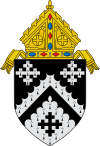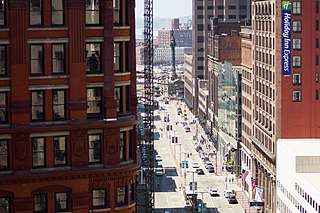
Euclid Avenue is a major street in Cleveland, Ohio, United States. It runs northeasterly from Public Square in Downtown Cleveland, passing Playhouse Square and Cleveland State University, to University Circle, the Cleveland Clinic, Severance Hall, Case Western Reserve University's Maltz Performing Arts Center, Case Western Reserve University and University Hospitals Case Medical Center. The street runs through the suburbs of East Cleveland, Euclid, and Wickliffe, to Willoughby as a part of U.S. Route 20 and U.S. Route 6. The HealthLine bus rapid transit line runs in designated bus lanes in the median of Euclid Avenue from Public Square to Louis Stokes Station at Windermere in East Cleveland.

St. Paul's Episcopal Church is a Richardsonian Romanesque-styled church built in 1882 in Milwaukee, Wisconsin in the Episcopal Diocese of Milwaukee. Noted for its Tiffany windows, it is listed on the National Register of Historic Places and is a designated Milwaukee Landmark.

St. Gregory's Abbey is an American monastic community of men living under the Rule of St. Benedict within the Episcopal Church. The abbey is located near Three Rivers in St. Joseph County, Michigan.
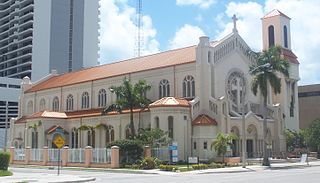
Trinity Episcopal Cathedral in Miami, Florida is the cathedral church of the Episcopal Diocese of Southeast Florida. It is located at North Bayshore Drive a short distance north of the Venetian Causeway, near the Carnival Center in Miami. On October 10, 1980, it was added to the U.S. National Register of Historic Places.

St. John's Episcopal Church is located at 2600 Church Avenue in the Ohio City neighborhood of Cleveland, Ohio. St. John's is the oldest consecrated building in Cuyahoga county. This stone gothic revival church building was designed by Hezekiah Eldredge and built beginning in 1836 and was completed 1838. Eldridge was probably familiar with John Henry Hopkins' "An Essay on Gothic Architecture", the first book on Gothic ecclesiastical architecture to be published in the United States. St. John's is a good representative of a small group of American churches inspired by Hopkins' book.

St. Luke's Episcopal Church, formerly the Episcopal Church of the Resurrection, is a historic Episcopal church in the Sayler Park neighborhood of Cincinnati, Ohio, United States. Designed in the 1870s by master architect Samuel Hannaford, it has been named a historic site.

Sidney Rose Badgley was a prominent start-of-the-20th-century Canadian-born architect. He was active throughout the United States and Canada, with a significant body of work in Cleveland.

The Shrine Church of St. Stanislaus is the home of a Catholic parish within the Diocese of Cleveland. St. Stanislaus is one of the major historic centers of Polish life in Cleveland, Ohio, especially for Poles with roots in Warsaw and surrounding areas, and is often called the mother church for Cleveland's Polish population. The shrine is located at the intersection of Forman Ave. and East 65th St., in a part of the South Broadway neighborhood previously known as Warszawa; today the area is known as Slavic Village. The church, the neighborhood, and the larger surroundings are GNIS named features.

St. Mary's Episcopal Church, at 1307 Holmes Street in downtown Kansas City, Missouri, is an Episcopal church in the Anglo-Catholic tradition. It is part of the Diocese of West Missouri.

St. Paul's Episcopal Church is a parish of the Episcopal Church in Cleveland Heights, Ohio. The current interim rector is the Rt. Rev. Jeffrey Lee. The two most recent rectors include the Rev. Jeanne Leinbach and the Rev. Alan M. Gates. The Rev. Patricia Rose, the Rev. Rose Anne Lonsway, and the Rev. Gabriel Lawrence serve as assistant rectors. St. Paul's is a leading church and has the largest congregation in the Episcopal Diocese of Ohio.

Grace Episcopal Church is the second oldest Episcopal congregation in Chicago, Illinois, United States. Since December 1985 it has occupied its 6th location, in a former printing works located at 637 South Dearborn Street in the Printer's Row neighborhood. Now also called Grace Place, the historic 3-story redbrick late 19th century Arts and Crafts building is a contributing property in the South Dearborn Street-Printing House Row North Historic District. Grace Place is also listed in the City of Chicago's Chicago Landmarks Historic Resources Survey.

Charles Frederick Schweinfurth was an American architect in Cleveland, Ohio. His brother Julius Schweinfurth was also an architect and they did some projects as a partnership.
Coburn & Barnum was a Cleveland, Ohio architectural firm from 1878 to 1897. It was established by Forrest A. Coburn and Frank Seymour Barnum. The firm also included W. Dominick Benes and Benjamin S. Hubbell for one year and was known as Coburn, Barnum, Benes & Hubbell until 1897, when Benes and Hubell departed to establish their own firm Hubbell & Benes. After their departure and Coburn's death, Barnum formed F. S. Barnum & Co. with Albert Skeel, Harry S. Nelson, Herbert Briggs, and Wilbur M. Hall. Barnum also served as consulting architect to the Cleveland Board of Education. He retired in 1915 having designed more than 75 school buildings, the Caxton Building (1903) and the Park Building (1904), an early example of reinforced concrete floor slabs. The firm continued after his 1915 retirement under the name of Briggs & Nelson.
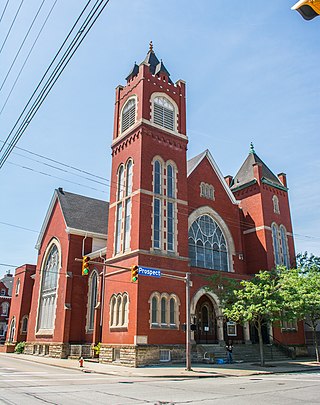
Zion Lutheran Church is a historic Lutheran church located along Prospect Avenue near downtown Cleveland, Ohio, United States. Formed in the 1840s, the congregation built the present building shortly after 1900, along with an adjacent church school. Both buildings have been named historic sites. The school is no longer open.

St. Paul's Episcopal Cathedral, is located in downtown Des Moines, Iowa, United States. It is the cathedral church of the Episcopal Diocese of Iowa. The building was listed on the National Register of Historic Places as St. Paul's Episcopal Church.

St. Paul's Episcopal Church in Chattanooga, Tennessee, is a downtown congregation of the Episcopal Church. It is one of the largest congregations in the Episcopal Diocese of East Tennessee.

St. Paul's Episcopal Church is a historic Episcopal parish in Medina, Ohio, United States. Formed in the 1810s as Medina's first church, it worships in a high Gothic Revival church building constructed in the 1880s, which has been named a historic site.

St. Henry's Catholic Church is a historic Catholic parish in the rural community of Harriettsville in the southeastern part of the U.S. state of Ohio. Established for German settlers in the 1860s, it worships in a landmark church building constructed in the 1890s. As the only stone building in the area and the work of a prominent architect, it has been named a historic site.

The Andrew and James Dall Houses are a pair of historic residences in the Central neighborhood of Cleveland, Ohio, United States. Erected in the late nineteenth century, they were home to two of the city's leading builders, and they have together been named a historic site.
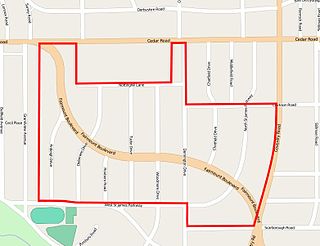
The Euclid Golf Allotment, also known as the Euclid Golf Historic District, is a historic district located in Cleveland Heights, Ohio, in the United States. Roughly bounded by Cedar Road, Coventry Road, West St. James Parkway, and Ardleigh Drive, the 142-acre (0.57 km2) site contains primarily residential homes built between 1913 and 1929. The historic district is built on land formerly owned by John D. Rockefeller and at one time leased to the Euclid Golf Club for its back nine holes, and it takes its name from this historic factoid. The Euclid Golf Allotment is a largely undisturbed example of an early 20th century planned community containing American Craftsman, Colonial Revival, French Renaissance Revival, Italian Renaissance Revival, Prairie School, Shingle Style, and Tudor Revival architecture.























